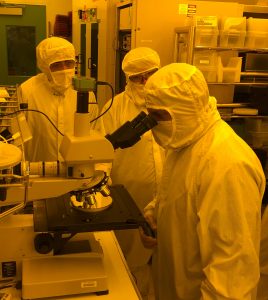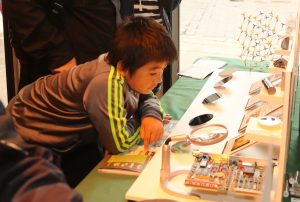Education and workforce development
Education is, of course, at the core of the university mission. After all, an educated, motivated and diverse workforce is essential for industry to thrive. For the U.S. to regain worldwide leadership in microelectronics, a dramatic expansion of the size and diversity of the microelectronics workforce is imperative. There is no more strategic convergence of interests among university, industry, and government than the education of the next generation of technicians, engineers, scientists, and technical leaders in microelectronics.
The university system in the U.S. attracts the best talent from all over the world to its graduate and postdoctoral programs. Our resources, our meritocratic system, and promising long-term career prospects constitute the magnet. The bulk of this talent remains in the U.S. and joins the university ranks or transitions to industry or national labs. The roster of extraordinarily accomplished leaders who have taken this path is long and distinguished.
 Considerably more so than in other countries, U.S. educational programs have combined hands-on education involving rich project-based experiences, design exercises and research projects, with a well-balanced grounding in fundamentals. The guiding principle is that active student engagement promotes better learning. U.S. educational programs also enjoy a rich culture of industry internships at the graduate and undergraduate level, when students have an opportunity to acquire practical skills, learn about career prospects, and contribute towards college costs.
Considerably more so than in other countries, U.S. educational programs have combined hands-on education involving rich project-based experiences, design exercises and research projects, with a well-balanced grounding in fundamentals. The guiding principle is that active student engagement promotes better learning. U.S. educational programs also enjoy a rich culture of industry internships at the graduate and undergraduate level, when students have an opportunity to acquire practical skills, learn about career prospects, and contribute towards college costs.
Still, in the words of industry insiders, “the U.S. educational system is failing to produce a sufficient number of American workers and students with the necessary STEM expertise to meet the needs of the semiconductor industry.” 2 Among undergraduates with interest in STEM disciplines, enrollment in the “hard disciplines” has been withering for many years in favor of majors such as computer science. That this is also a worldwide trend should not serve as consolation. The challenge goes beyond the training of engineers and PhD candidates in microelectronics. Indeed, it is commonly estimated that 50 technicians are needed to support every PhD working in the industry.
Underlying this apathy towards microelectronics-related disciplines is a lack of awareness of how microelectronics can help address the world’s most pressing problems, something that undergraduates tell us is motivating. They also do not see fulfilling careers at the other end of a very demanding course of study. This is a systemic failure that will require concerted collective action to correct. We need to come together through system-oriented multidisciplinary subjects, hands-on lab courses, research experiences, design exercises using modern computer-aided design (CAD) tools, well-crafted internship programs in industry, and support from industry mentors to attract students back to our disciplines. Research on pedagogy should explore new teaching methodologies that substantially shorten the long learning curve and reduce the high barrier for technology access that sits on the way to fulfilling project and internship experiences. Implementing these initiatives will require sizable investments in research and educational facilities and in staff support. All this should be done without distracting ourselves from teaching the fundamentals—more important than ever in these rapidly evolving disciplines.
We need to come together through system-oriented multidisciplinary subjects, hands-on lab courses, research experiences, design exercises using modern computer-aided design (CAD) tools, well-crafted internship programs in industry, and support from industry mentors to attract students back to our disciplines.
Fellowships for master’s level studies would also drive promising students to seek higher-level specialization through advanced courses, more intense design and project experiences, and rewarding internships. At present, stand-alone master’s level studies that require a thesis but do not lead to a PhD have a high cost that is tough to justify through involvement in research via research assistantships. A well-targeted masters-level scholarship program, perhaps involving industrial internships as some universities have done, would expand the pool of qualified graduates around the country. In addition, fellowships at the PhD and postdoc levels will enlarge the ranks of highly qualified engineers and scientists in microelectronics and contribute to innovation by derisking the launch of new initiatives and smoothing research support fluctuations.
 A national microelectronics workforce development initiative must seek not just to expand the pool of qualified graduates in all relevant disciplines and at all levels but to also dramatically enrich its diversity in every dimension. Straightforward scale up of existing programs at institutions that are well established in the ecosystem will not accomplish this. The involvement of educational institutions that for much too long have been on the sidelines of the microelectronics enterprise is imperative. Well-established universities should open their facilities and share their resources and know-how with a wide range of colleges and community colleges and should support the creation of educational programs, hands-on and research experiences, and internship opportunities for their students. Outreach efforts to middle school, high school, and community colleges must expand and deepen their reach. In all these programs, particular attention must be given to underserved institutions across the entire geography of the U.S. Many opportunities exist for economies of scale here if industry and academia coordinate activities across the country to develop and share resources and best practices.
A national microelectronics workforce development initiative must seek not just to expand the pool of qualified graduates in all relevant disciplines and at all levels but to also dramatically enrich its diversity in every dimension. Straightforward scale up of existing programs at institutions that are well established in the ecosystem will not accomplish this. The involvement of educational institutions that for much too long have been on the sidelines of the microelectronics enterprise is imperative. Well-established universities should open their facilities and share their resources and know-how with a wide range of colleges and community colleges and should support the creation of educational programs, hands-on and research experiences, and internship opportunities for their students. Outreach efforts to middle school, high school, and community colleges must expand and deepen their reach. In all these programs, particular attention must be given to underserved institutions across the entire geography of the U.S. Many opportunities exist for economies of scale here if industry and academia coordinate activities across the country to develop and share resources and best practices.
Universities also should play a role in supporting the continuing education needs of the microelectronics industry workforce. In such rapidly changing disciplines, new materials, technologies, processes, and techniques emerge all the time. Universities originate many of these innovations and are in a privileged position to prepare the existing workforce to take advantage of them. Recent advances and experiences in online pedagogy make it eminently feasible to create and share educational materials on a national scale.
² 2019 SIA Blueprint for Sustained U.S. Leadership in Semiconductor Technology